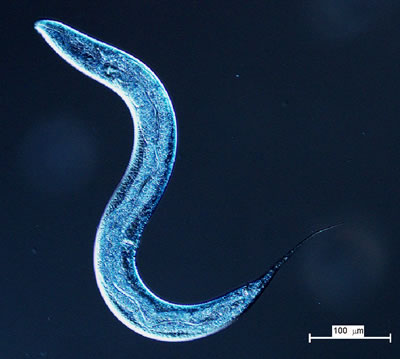In 1991, a now famous ancient tattooed mummy, dated from approximately 3300 B.C. known as “Ötzi the Ice Man” was  found frozen in a glacier on what is now the Austria-Italy border of the Otzal alps, and this is why he was named Otzi. He is Europe’s oldest known natural human mummy ever discovered, and he also had approximately 50 tattoos making him the oldest tattooed mummy as well.
found frozen in a glacier on what is now the Austria-Italy border of the Otzal alps, and this is why he was named Otzi. He is Europe’s oldest known natural human mummy ever discovered, and he also had approximately 50 tattoos making him the oldest tattooed mummy as well.
One of the little known facts about “Ötzi”, was that he suffered from worms known as threadworms (pinworms) and whipworms (Trichuris trichiura), and near his frozen body in the cave were found possible health remedies for these parasites such as the birch fungus called Piptoporus betulinus. This fungus is well-known for its laxative and anti-parasitic/worm purging properties.
This is very interesting because it falls in line with the worm research that I have been sharing with you here on Gnostic Warrior over the last two years. If we put all the worm and health facts together, we can now safely say that Ötzi the Ice Man is one of the oldest examples of humans that proves they had known about these man destroying worms for thousands of years.
After the corpse of Ötzi had been thoroughly examined and x-rayed, his skin tissues and the contents of his intestines had been examined microscopically in order to try to determine his cause of death, any illnesses he may have had, and also what he had eaten shortly before death.
It was in his gut where the scientist had found that he was infested with parasitic worms, and their eggs. Ötzi also suffered from tooth decay, and of advanced gum disease. I have written about this health problem before, and the fact that almost all ancient cultures had attributed toothaches and mouth problems to worms who were said to also live in our teeth and gums. He also had extremely high levels of arsenic in his system which may have been from either ingesting arsenic type medicines to combat the worms, or from the making of weapons from smelting copper. I believe it was the former.
Found near the Iceman’s body was what we can call an ancient medical kit for combatting worms with birch fungus, Piptoporus betulinus, that has a purging effect and can bring on diarrhea in order to pass the worms and their eggs. They also found various herbs, grains, and seeds such as flax and poppy that were discovered, as well as kernels of sloes (small plumlike fruits of the blackthorn tree) and various seeds of berries growing in the wild.
The New York Times reported on this in 1998:
An anthropologist reported last week that the Iceman was also providing a rare glimpse of prehistoric medicine, including his apparent use of a natural laxative and antibiotic.
Among the Iceman’s possessions were two walnut-size lumps with a consistency somewhere between cork and leather. Each lump was pierced and tied to a leather thong, perhaps so it could be fastened to some part of his clothing or belt. At first, the material was mistakenly described as tinder for starting fires.
But Austrian microbiologists have identified the lumps as the fruit of the birch fungus, Piptoporus betulinus, which is common in alpine and other cold environments. If the fungus is ingested, it can bring on short bouts of diarrhea. It also contains oils that are toxic to certain parasitic bacteria, thus acting as a form of nature’s own antibiotics.

Moe is the founder of GnosticWarrior.com. He is a father, husband, author, martial arts black belt, and an expert in Gnosticism, the occult, and esotericism.





![How the same holy man, being detained there by sickness, by his prayers quenched a fire that had broken out among the houses, and was himself cured of his infirmity by a vision [429 A.D.] | Book 1 | Chapter 18 How the same holy man, being detained there by sickness, by his prayers quenched a fire that had broken out among the houses, and was himself cured of his infirmity by a vision [429 A.D.] | Book 1 | Chapter 18](https://www.gnosticwarrior.com/wp-content/plugins/contextual-related-posts/default.png)

You really got a thing about worms dude! Thanks. Love your posts. I still can’t figure you out…LOL
So his home remedies did not work?
He was murdered. In any event, some of us can never kill all the worms that infest us because we are born and live with them. The key to not having an early death as a result of the worm is to conquer him before he conquers you. Environments, diet and medicines all play a crucial role in battling the worm (AKA serpent or dragon).
Yes brother, and this is my destiny to reveal these ancient teachings for man is but a worm in which we are born from the sperm and eaten alive by the immortal worm. 😉 These revelations I AM making will make sense my brother as time moves forward. Please watch the synchronicities of my articles with current events. They all interrelate to one another for this is the Apocalypse and me, a reincarnated soul with the mark of the Lord born to bring the light.